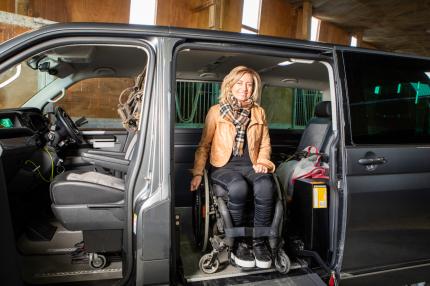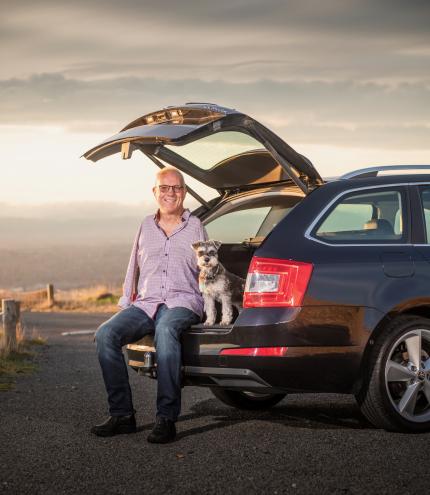
How vehicles are modified for drivers with disabilities
Catriona Williams mightn’t be able to move her body as freely as she used to, but that hasn’t stopped the former New Zealand equestrian champion turned tetraplegic from living an independent, fun-filled life.
Road trips with family and friends are plentiful and so, too, are weekly excursions to the supermarket and regular trips from her Wairarapa home to Auckland’s Karaka horse sales. All this is and more is possible in her modified vehicle, which she drives securely from her wheelchair.

It involves just three clicks of a button: the first to open the door of her 2020 Volkswagen van, another for the wheelchair ramp to descend, the third for the vehicle to lower, enabling safe and easy access. “I can be secure behind the wheel in a matter of seconds,” Catriona says. “It’s not quite as quick as it would be if I were able-bodied, but it’s not far off. Probably the most frustrating thing is waiting for the ramp to go up and down!”
It would seem nothing is impossible for Catriona who, after falling from her horse in 2002, has gone on to complete the New York City Marathon, climb to Everest Base Camp on a handcycle, start her own research trust in support of a cure for spinal cord injury and be recognised in the 2014 Queen’s Birthday Honours list as a Member of the New Zealand Order of Merit.
Yet it has been the ability to drive a vehicle independently, made possible with financial support from ACC, that has been Catriona’s ticket to freedom, giving her an opportunity she’s incredibly grateful for. “I’m very fortunate. This is not a cheap injury to live with, so having access to a good vehicle like this adds huge value to my quality of life,” she says.
“The hardest thing with a spinal cord injury is losing your independence. So, when you do get your wheels – the first being your wheelchair and the second your vehicle – it really is a big deal.
“It’s not only freedom for you, but freedom for your partner, friends and family on whom you have become so dependent; it enables you to take them places rather than the other way around.”
There’s an extensive team of experts – including specialised engineers, transport occupational therapists and driving instructors – who work to ensure a vehicle is fitted with the appropriate features for its driver’s specific needs and, importantly, that they integrate safely on New Zealand roads.
Catriona had her van imported from the United Kingdom – the first of nine of the same make and model for others living with disabilities – with some modifications, including the wheelchair ramp and special hand controls, already made. The rest of the modifications were tailored in New Zealand specifically to accommodate Catriona’s needs.
A ‘blinker lever’ controls the indicators, lights and power while a fork-like device attached to the steering wheel enables easier manoeuvring, as Catriona has limited movement in her hands and arms. The seat belt and buckle sit higher off the floor to accommodate her wheelchair; an ‘easy lock system’ secures the chair safely behind the wheel.
Standard foot pedals remain in place so that an able-bodied person can also drive it. “It makes it a much more enjoyable roadie when I’m away with girlfriends because anyone can share the driving,” Catriona says.
Margaret Hawkes is the director of Freedom Mobility and Vehicle Adaptions, companies that offer modifications to vehicles for people living with both temporary and life-long disabilities.
She says the new technologies like those fitted to Catriona’s van – many of them originally imagined here in New Zealand – are making driving more accessible than ever before, regardless of a person’s ability to move around in the conventional way. Such gadgets include a robot-like device – invented in New Zealand and sold worldwide – which emerges from the back of a vehicle at the push of a button and moves a wheelchair in and out of the boot. Other state-of-the-art technology comes from a Christchurch-based business that 3D-prints indicators which are installed into a vehicle’s headrest and activated via head movement and pressure.

Steve Roome has them in his shiny black 2015 Skoda Octavia, a car he bought with a grant from the Lotteries Commission. The Christchurch father of two was born without arms, yet he still manages to manoeuvre his vehicle up the ski slopes for a day on the mountain and to visit friends in South Canterbury by steering the car with his left foot.
The headrest indicators allow him to turn safely without taking his foot off the steering wheel. Headlights are activated by pressing down the middle of the headrest. There’s keyless entry, a push-button start mechanism and automatic window wipers, making the car feel “as if it were made for me,” laughs Steve.
He says while the ability to drive has undoubtedly given him freedom and extra zest for life, it’s also been a key tool in breaking down public perception on the capabilities – or rather limitations – of people with disabilities.
“It’s so important to been seen out and about. If you were to walk past my car in a carpark, you wouldn’t know [about my disability] and I kind of like that. I kind of like to blend into society as much as possible.”
Steve says it’s also significant for others living with a disability to see him – with no arms – driving and thriving. “It may empower someone with an impairment to know that with the right support and training, they too can do it.”
Reported by Monica Tischler for the Spring 2022 issue of AA Directions magazine.
